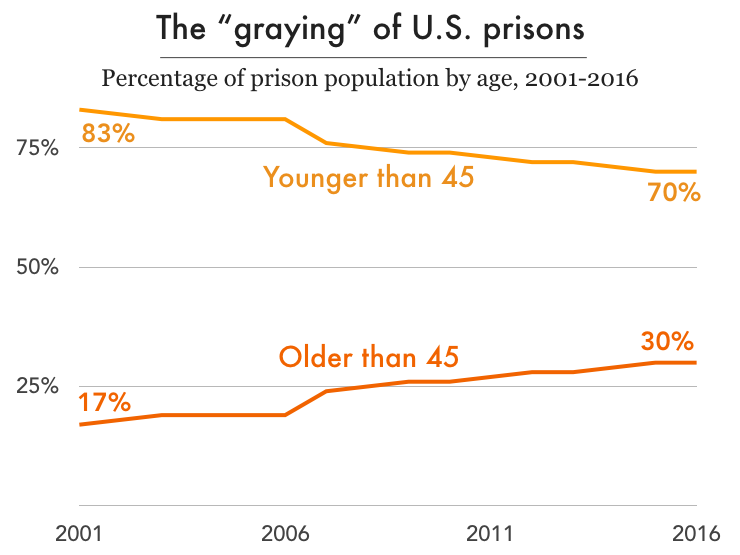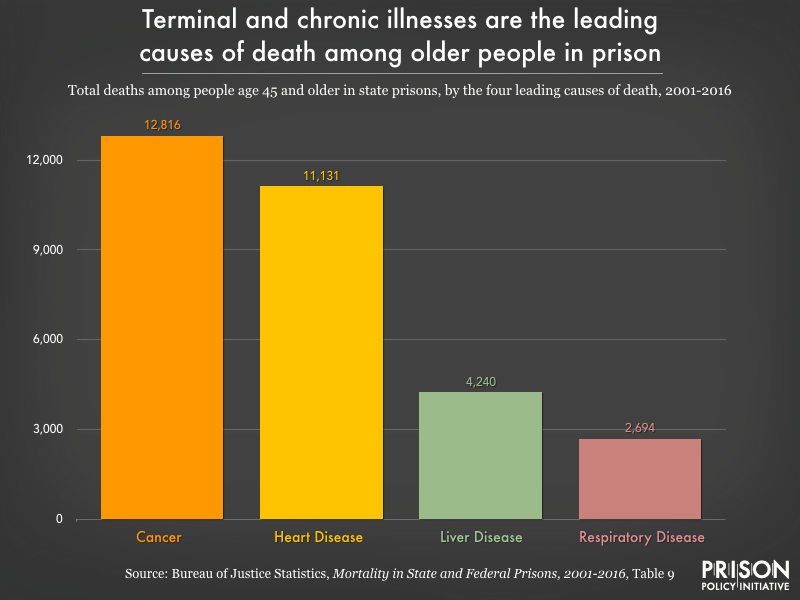What Percent of Released Murderers Kill Again How Many People Are Killed by Death Penalty Per Year
Deaths in state prisons are on the ascent, new information shows. What can exist done?
Prison systems have shown they are unprepared and unwilling to care for an crumbling prison house population - whether by improving healthcare or expanding compassionate release.
by Emily Widra, February 13, 2020
A newer article about state prison deaths with data from 2022 is now available. We suggest using that commodity instead of this one.
A new Bureau of Justice Statistics written report released yesterday shows that from 2022 to 2016, the number of deaths in U.S. country prisons increased from 296 to 303 per 100,000 people. What accounts for these deaths?
Chronic illnesses continue to be the leading crusade of expiry in country prisons, according to the report — far outpacing drug- and alcohol-related deaths, accidents, suicides, and homicides combined. The number of deaths from chronic illness — including a growing number of deaths from cancer in prison, at a time when overall deaths from cancer are going downwards — is a testament to the extremely poor healthcare incarcerated people receive. It also highlights the ways that prisons are unable and unwilling to intendance for their elderly residents, who comprise a growing share of the prison house population.

Sources: Bureau of Justice Statistics, Mortality in State and Federal Prisons, 2001-2016 and Bloodshed in Local Jails and State Prisons, 2000-2013
Prison accelerates aging and increases the risk of early death from disease
As nosotros've written almost previously, each year of time served in prison house takes two years off an individual'southward life expectancy. Testify suggests that the reason for this is that incarcerated people experience "accelerated physiological crumbling." Prison ages incarcerated people by 10 to 15 years on average, which in turn makes them more vulnerable to chronic health atmospheric condition earlier in life than would exist expected. As we see in the new prison mortality data, these chronic weather – cancer, heart affliction, liver disease, and respiratory diseases – are amid the virtually frequent causes of death in state prisons.

Researchers take identified a number of reasons why prisons increase the gamble of disease and early death (for a concise review, see Novisky 2018). These include, only are not express to: varying degrees of health literacy and capital amid incarcerated people; constraints on transportation to necessary appointments exterior the prison house; and inadequate healthcare in prisons due to insufficient resources, limited medical providers, restrictions on medication administration, and treatment bias because of stigmas attached to incarcerated patients. And – particularly for older or otherwise more vulnerable people – punitive practices similar solitary confinement chemical compound existing physical and mental wellness concerns and risks.
Prisons are not prepared for the health problems and mortality of their aging populations
Nationally, the imprisonment rate for people over 45 years old has more than doubled over the past three decades while the rate for those under 45 has actually dropped slightly. Mortality has become an urgent issue in places like the Louisiana Land Penitentiary ("Republic of angola"), where the average age is over twoscore and the average sentence is longer than 90 years. With thousands of aging adults facing the prospect of dying in prison house in the coming years, how are prison systems preparing to handle the increased physical and psychological needs of the graying prison house population? In short, they're non preparing at all.
While the country incarcerates more older adults for longer sentences, prison systems have not adapted to the changing needs of the prison population. Despite examples of increased spending on prison healthcare, admission to necessary healthcare remains inadequate. There are ofttimes lapses between prescription refills, also as unmet dietary needs and unaffordable medical copays. Nosotros know that copays jeopardize the health of incarcerated populations, staff, and the public because when healthcare is unaffordable, sick people avoid the physician, and diseases are likely to worsen and require more than aggressive care. Nonetheless most states withal require copays to run across medical staff behind confined. And fifty-fifty when incarcerated people practice see medical staff, they face long waits: older adults in federal prisons wait an average of 114 days to see needed medical specialists in cardiology and pulmonology, which also puts them at risk for late diagnoses or no treatment at all.
Recent research from Prof. Meghan Novisky reveals how older incarcerated adults cope with the difficulties of accessing healthcare in prison house. In her extensive qualitative study, Novisky finds that older incarcerated adults must rely on their networks – both in and outside of prison – and strategically utilise the limited resources bachelor to them. Specifically, these older adults attempt to access health information from outside, from the prison library, and from other incarcerated people with medical backgrounds; they utilize the commissary and access to the kitchen to supplement the insufficient diet provided them; and they doggedly abet for themselves with providers and through the grievance process, all in an effort to get their basic health needs met.
Beyond individual health outcomes, the financial burdens of the aging prison population tin can't be overlooked: intendance for this population costs 2-3 times more than than for their younger counterparts. The federal prison house system reports spending 5 times more than on medical care and xiv times more on medications per inmate in facilities with higher percentages of older inmates.
Bringing a measure of dignity to death in prison: Hospice programs
As the recent BJS report reminds us, mortality rates in prison are unlikely to tedious, given the crumbling population and systemic healthcare issues. This reality begs the question: what does bloodshed backside bars really await like for the people who are dying?
Currently, less than 4% of prisons have hospice programs. Most prisons and jails were not built with any consideration for the fact that they would house people dying of cancer, pulmonary diseases, liver failure, and dementia. But hospice has go ane of the few humane attempts to address mortality in prison.
Hospice care involves a squad of providers who care for people with life-limiting illnesses and their families with medical intendance, pain management, and emotional and spiritual support. The hospice model of care, based on a belief that every person has the correct to die pain-costless and with dignity, has fabricated strides to fit into what Fleury-Steiner (2008) calls "the prison'south 'natural environment' of aggressive discipline and custody."
"When speaking on end-of-life care, no 1 should be excluded. Dying with dignity is an essential component of our humanity and needs to exist extended even into the shadows of our society."
– Marvin Mutch, Human Prison Hospice Projection
About half of these prison hospice programs use incarcerated people as volunteers or equally employed (and underpaid) caregivers. They become a crucial part of the care team, given that medical staff are often spread thin and correctional officers don't accept the necessary preparation to provide cease-of-life intendance. (Incarcerated volunteers who work in hospice exercise receive appropriate grooming.)
While having access to hospice care in prison is certainly meliorate than dying there without such care, dying in prison is a bleak scenario no matter what. Ane hospice patient at the California Medical Facility expressed this succinctly to a New York Times journalist entering the hospice unit of measurement, greeting her with, "Welcome to death row."
The alternative: Compassionate release
For terminally sick incarcerated people, the other option is compassionate release: the early release of individuals who are facing imminent death and do not pose a threat to the public. Compassionate release was created by Congress to release incarcerated people "when it becomes 'caitiff' to proceed them in prison whatever longer." This option allows incarcerated people to seek hospice intendance outside of prison, a adventure for dignified death, and fourth dimension with family unit. Moreover, it has the practical benefit of reducing medical costs to the state and federal government.
Yet, this more humane release mechanism is extraordinarily underutilized, for a number of bad reasons: narrow eligibility requirements, a burdensome application process, protracted hearings, third party veto power, a lack of formal timelines, reluctance of providers to provide a prognosis, lack of medial knowledge of parole board members, and no systematic procedures for tracking applications and decisions. According to The New York Times, between 2013 and 2017, the federal Agency of Prisons approved but 6% of the five,400 compassionate release applications received; meanwhile, 266 other applicants died in prison. Their assay of federal prison information shows that it takes over half-dozen months, on average, for an incarcerated person to receive an respond on their compassionate release application from the BOP. In one tragic example, prison officials denied an application for someone because the BOP determined he had more than than 18 months to live, despite prison doctors' prognosis of less than half-dozen months. Two days after receiving the denial, he died. With a timeline similar that, it is no wonder that the number of older adults dying behind confined continues to abound.
montgomeryhicharrom.blogspot.com
Source: https://www.prisonpolicy.org/blog/2020/02/13/prisondeaths/
ارسال یک نظر for "What Percent of Released Murderers Kill Again How Many People Are Killed by Death Penalty Per Year"